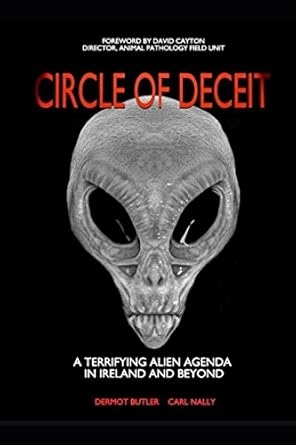Oweynagat: A Haunting Cave at the Heart of Ireland's Samhain Legends
Mythology/Folklore/History
Thursday 10th, October 2024
4 minute read.
Hidden in the countryside of County Roscommon, near the quiet end of a rural cul-de-sac, lies Oweynagat (Cave of the Cats), an archaeological and mythological site that has captured the imagination for centuries. Part of the Rathcroghan complex, which includes over 250 ancient monuments, Oweynagat stands out for its unique combination of natural cave formations and man-made structures. More significantly, it has long been associated with Samhain, the ancient Celtic festival which gave rise to Halloween.
Oweynagat is a limestone cave, extending for 37 metres beneath the ground. The entrance, a natural fissure in the rock, was fortified in the medieval period by the construction of a souterrain, a type of underground passage often used for storage or protection. The souterrain is lined with stone, and two Ogham stones are positioned at key points within it. These stones bear ancient inscriptions, one of which reads: ‘VRẠICCI/ MAQI MEDVVI’ or "The Stone of Fróech, son of Medb". This inscription ties the site to Queen Medb, a key figure in Irish mythology, particularly in the epic tale Táin Bó Cúailnge (The Cattle Raid of Cooley).
The cave’s mythology runs deep, intertwining with the ancient stories of the Ulster Cycle. In one tale, “Bricriu’s Feast”, three heroes, Lóegaire, Conall Cernach, and Cú Chulainn are tested by a challenge from three ferocious cats released from Oweynagat. Both Lóegaire and Conall flee in fear, but Cú Chulainn faces the challenge and is declared the victor. Another story, “The Adventures of Nera”, describes how the cave opens into the Otherworld on Samhain night. According to the legend, Nera enters the cave after witnessing a vision of the destruction of Rathcroghan. Inside, he experiences time differently, marries a woman, and brings firewood to the king of the Otherworld. This powerful connection between Oweynagat and the Otherworld is why it is sometimes referred to as “Ireland’s gate to Hell”.
The cave is also known for the terrifying creatures said to emerge from its depths on Samhain. These stories include three-headed beasts, flocks of birds that destroy crops, and a herd of pigs that multiply endlessly, eating everything in their path. The association of Oweynagat with Samhain made it a central point of fear and fascination in medieval Irish culture, a place where the boundaries between this world and the supernatural realm thinned.
Samhain, celebrated around the 31st of October, marked the end of the harvest and the beginning of the darker half of the year. It was believed that during this time, the barrier between the living and the dead was at its weakest, allowing spirits and creatures from the Otherworld to walk freely among the living. Oweynagat’s association with these stories made it a symbolic "door" to this world of spirits, and the festival of Samhain eventually evolved into what is now celebrated globally as Halloween.
Oweynagat is not only steeped in ancient tales but is also part of local folk tradition. The cave is located on private farmland, close to a family home which was once a local "rambling house", a place where people gathered to share stories and songs. One local tale tells of the night a storm arose as a woman gave birth in the house, and eerie screams of cats were heard from the cave. Fearing a supernatural occurrence, the newborn was baptised that night, and as soon as the ritual was complete, the storm stopped, and the cats fell silent.
Today, Oweynagat is protected under Ireland’s National Monuments Act and Annex I of the Habitats Directive, as it holds both historical and environmental significance. Though it is on private land, visitors interested in seeing the cave can arrange tours through the Rathcroghan Visitor Centre in Tulsk, County Roscommon.
Rathcroghan, where Oweynagat is located, has long been a rich source of archaeological and mythological discovery. In 2014, as part of the Ogham3D project, the Discovery Programme created a detailed 3D model of the site, allowing a new generation to explore its depths from afar. Oweynagat continues to be a place where ancient history and folklore collide, creating a space that is as eerie as it is fascinating.
While many archaeological sites across Ireland hold deep cultural and historical significance, Oweynagat’s unique combination of myth, history, and geology sets it apart. For centuries, it has been the source of fearsome stories, inspiring both medieval manuscripts and local folklore. Whether as Ireland’s gate to Hell or an entrance to the Otherworld, it remains a key site for understanding Ireland’s rich cultural heritage.
For those wishing to explore Oweynagat and the wider Rathcroghan complex, contacting the Rathcroghan Visitor Centre is essential, as access is strictly managed to preserve both the archaeological site and its natural surroundings.
Oweynagat is a limestone cave, extending for 37 metres beneath the ground. The entrance, a natural fissure in the rock, was fortified in the medieval period by the construction of a souterrain, a type of underground passage often used for storage or protection. The souterrain is lined with stone, and two Ogham stones are positioned at key points within it. These stones bear ancient inscriptions, one of which reads: ‘VRẠICCI/ MAQI MEDVVI’ or "The Stone of Fróech, son of Medb". This inscription ties the site to Queen Medb, a key figure in Irish mythology, particularly in the epic tale Táin Bó Cúailnge (The Cattle Raid of Cooley).
The cave’s mythology runs deep, intertwining with the ancient stories of the Ulster Cycle. In one tale, “Bricriu’s Feast”, three heroes, Lóegaire, Conall Cernach, and Cú Chulainn are tested by a challenge from three ferocious cats released from Oweynagat. Both Lóegaire and Conall flee in fear, but Cú Chulainn faces the challenge and is declared the victor. Another story, “The Adventures of Nera”, describes how the cave opens into the Otherworld on Samhain night. According to the legend, Nera enters the cave after witnessing a vision of the destruction of Rathcroghan. Inside, he experiences time differently, marries a woman, and brings firewood to the king of the Otherworld. This powerful connection between Oweynagat and the Otherworld is why it is sometimes referred to as “Ireland’s gate to Hell”.
The cave is also known for the terrifying creatures said to emerge from its depths on Samhain. These stories include three-headed beasts, flocks of birds that destroy crops, and a herd of pigs that multiply endlessly, eating everything in their path. The association of Oweynagat with Samhain made it a central point of fear and fascination in medieval Irish culture, a place where the boundaries between this world and the supernatural realm thinned.
Samhain, celebrated around the 31st of October, marked the end of the harvest and the beginning of the darker half of the year. It was believed that during this time, the barrier between the living and the dead was at its weakest, allowing spirits and creatures from the Otherworld to walk freely among the living. Oweynagat’s association with these stories made it a symbolic "door" to this world of spirits, and the festival of Samhain eventually evolved into what is now celebrated globally as Halloween.
Oweynagat is not only steeped in ancient tales but is also part of local folk tradition. The cave is located on private farmland, close to a family home which was once a local "rambling house", a place where people gathered to share stories and songs. One local tale tells of the night a storm arose as a woman gave birth in the house, and eerie screams of cats were heard from the cave. Fearing a supernatural occurrence, the newborn was baptised that night, and as soon as the ritual was complete, the storm stopped, and the cats fell silent.
Today, Oweynagat is protected under Ireland’s National Monuments Act and Annex I of the Habitats Directive, as it holds both historical and environmental significance. Though it is on private land, visitors interested in seeing the cave can arrange tours through the Rathcroghan Visitor Centre in Tulsk, County Roscommon.
Rathcroghan, where Oweynagat is located, has long been a rich source of archaeological and mythological discovery. In 2014, as part of the Ogham3D project, the Discovery Programme created a detailed 3D model of the site, allowing a new generation to explore its depths from afar. Oweynagat continues to be a place where ancient history and folklore collide, creating a space that is as eerie as it is fascinating.
While many archaeological sites across Ireland hold deep cultural and historical significance, Oweynagat’s unique combination of myth, history, and geology sets it apart. For centuries, it has been the source of fearsome stories, inspiring both medieval manuscripts and local folklore. Whether as Ireland’s gate to Hell or an entrance to the Otherworld, it remains a key site for understanding Ireland’s rich cultural heritage.
For those wishing to explore Oweynagat and the wider Rathcroghan complex, contacting the Rathcroghan Visitor Centre is essential, as access is strictly managed to preserve both the archaeological site and its natural surroundings.



